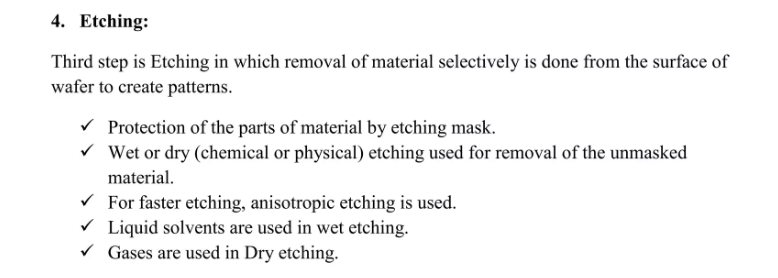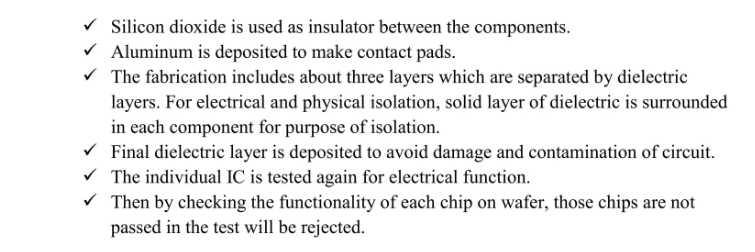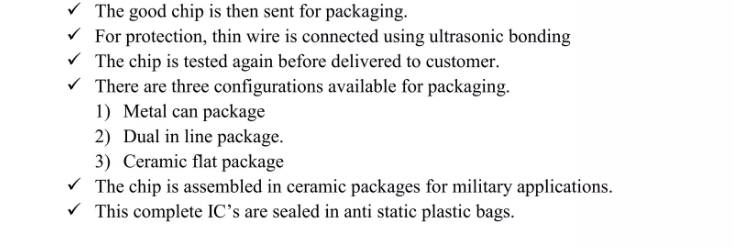Fabrication Process in VLSI #
Introduction
VLSI chips are made up of a series of fundamental stages, including crystal growth and wafer preparation, epitaxy, dielectric and polysilicon layer deposition, oxidation, lithography, and dry etching. The devices are formed on the chip during the fabrication process in VLSI. Devices are generated when a fixed-size substance crosses another material. To guarantee that the circuit functions properly, a set of design criteria must be followed while creating the devices. A fabrication facility is where VLSI chips are made. The circuit designer must understand the functions of various masks used in the manufacturing process, as well as how the masks are employed to specify various aspects of the devices on-chip. An Integrated Circuit (IC) is a semiconductor-based electronic network constructed in a single component. Impurities and other materials are introduced to the semiconductor surface in precise geometrical patterns throughout various manufacturing processes. The manufacturing operations are organised in three dimensions to create transistors and interconnects that make up the network.
Sequence of Fabrication Process in VLSI #
- Manufacture of silicon
- Wafer processing
- Lithography
- Growth and elimination of oxidants
- Ion implantation and diffusion
- Annealing
- Silicon deposition
- Metallisation
- Testing
- Assembly and packing
What is the use of the fabrication process in VLSI? #
Less Power Consumption: Since each gadget needs such a little quantity of energy, there is less power consumption. The charge on the capacitors that link the switches to each other consumes the majority of the power in a switching circuit. Because the components of a huge IC are so compact and close together, the capacitance is significantly less, resulting in less power. Less Testing Required: If you built the same circuit out of discrete ICs and other components, you’d have to test each one (before using it) for the various applications it may be used in. This is a lot of testing for 10,000 ICs. The components of a VLSI are dedicated to a particular purpose. Furthermore, the majority are in the centre of the VLSI and are inaccessible for testing. Only the function for which the complete circuit was intended may be tested. Increased Reliability: We have discovered that an IC’s dependability is proportional to the number of links it has to the outside world. So, if the function is built using a lot of smaller ICs coupled together, there are a lot of connections, and the dependability suffers as a result. There are fewer connections on the vlsi, and it is more reliable.
Steps involved in the IC Manufacturing Process #
- Lithography: The method of defining patterns on a wafer surface by depositing a thin homogeneous coating of viscous liquid (photo-resist). Baking hardens the photo-resist, which is then selectively removed by shining light through a reticle holding mask information.
- Etching: removing undesirable material from the wafer’s surface selectively. Etching agents are used to impart the photo-resist pattern on the wafer.
- Deposition: Various materials’ films are applied to the wafer. Physical vapour deposition (PVD) and chemical vapour deposition (CVD) are the most common methods used for this.
- Chemical Mechanical Polishing: A planarization procedure that involves saturating the wafer surface with a chemical slurry including etchant agents.
- Oxidation: Oxygen (dry oxidation) or H O (wet oxidation) molecules change silicon layers on top of the wafer to silicon dioxide during the oxidation process.
- Ion Implantation: This is the most common method for introducing dopant impurities into semiconductors. The ionised particles are accelerated and aimed towards the semiconductor wafer using an electrical field.
- Diffusion: After ion implantation, a diffusion step is employed to anneal bombardment-induced lattice defects.
Low-power VLSI digital circuits will continue to be in high demand in the burgeoning field of portable communications and computing systems in the future. These devices’ cost and life cycle will be determined not just by low-power production processes, but also by novel DFT approaches aimed at power reduction during testing. This is because typical DFT approaches are ineffective for evaluating low-power VLSI circuits since they impair manufacturing yield and dependability.
Steps Required for Fabrication Of IC





















